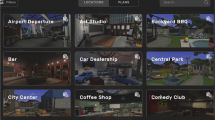Abstract
In technology-enhanced language learning environments, virtual reality (VR) has become an effective tool to support contextualized learning and promote immersive experiences with learning materials. This case study, using the qualitative research method, explored students’ attitudes and perceptions of engaging in VR language learning. Twenty-eight Chinese sophomores attended this VR project in a travel English unit. They wore VR headsets to watch 360 VR videos containing famous tourist attractions from four countries during a 6-week project. Data were collected from final reflections and interviews. Results of final reflections indicated that students showed positive feedback on this new teaching method in English learning. In addition, interview data present the advantages and disadvantages of implementing immersive VR learning in EFL classrooms.
Access this chapter
Tax calculation will be finalised at checkout
Purchases are for personal use only
Similar content being viewed by others
References
Godwin-Jones, R.: Augmented reality and language learning: from annotated vocabulary to place-based mobile games. Language Learn. Technol. 20(3), 9–19 (2016). https://www.scopus.com/inward/record.uri?eid=2-s2.0-84994627515&partnerID=40&md5=6d3aec75cd7321c12aa0d2acef7c8ad9
Parmaxi, A.: Virtual reality in language learning: a systematic review and implications for research and practice. Interact. Learn. Environ. (2020)
Warschauer, M.: Comparing face-to-face and electronic discussion in the second language classroom. CALICO J. 13(2–3), 7–26 (1995)
Dalgarno, B., Lee, M.: What are the learning affordances of 3-D virtual environments? Br. J. Edu. Technol. 41, 10–32 (2010)
Huang, H.W.: Effects of smartphone-based collaborative vlog projects on EFL learners’ speaking performance and learning engagement. Australas. J. Educ. Technol. 37(6), 18–40 (2021)
Berti, M.: Italian open education: virtual reality immersions for the language classroom. In: Comas-Quinn, A., Beaven, A., Sawhill, B. (eds.), New Case Studies of Openness in and Beyond the Language Classroom, pp. 37–47 (2019)
Makransky, G., Lilleholt, L.: A structural equation modeling investigation of the emotional value of immersive virtual reality in education [Article]. Educ. Tech. Res. Dev. 66(5), 1141–1164 (2018)
Chien, S.Y., Hwang, G.J., Jong, M.S.Y.: Effects of peer assessment within the context of spherical video-based virtual reality on EFL students’ English-Speaking performance and learning perceptions. Comput. Educ. 146 (2020)
Gruber, A., Kaplan-Rakowski, R.: The impact of high-immersion virtual reality on foreign language anxiety when speaking in public. SSRN Electron. J. (2022)
Riva, G., Mantovani, F., Capideville, C., Preziosa, A., Morganti, F., Villani, D., Gaggioli, A., Botella, C., Alcañiz Raya, M.: Affective interactions using virtual reality: the link between presence and emotions. Cyberpsychol. Behav. 10, 45–56 (2007)
Hu-Au, E., Lee, J.: Virtual reality in education: a tool for learning in the experience age. Int. J. Innov. Educ. 4 (2017)
Qiu, X.-Y., Chiu, C.-K., Zhao, L.-L., Sun, C.-F., Chen, S.-J.: Trends in VR/AR technology-supporting language learning from 2008 to 2019: a research perspective. Interact. Learn. Environ. (2021)
Allcoat, D., von Mühlenen, A.: Learning in virtual reality: effects on performance, emotion and engagement. Res. Learn. Technol. 26 (2018)
Lin, V., Barrett, N., Liu, G.-Z., Chen, N.-S., Morris, Jong, S.-Y.: Supporting dyadic learning of English for tourism purposes with scenery-based virtual reality. Comput. Assisted Language Learn. (2021)
Berti, M., Maranzana, S., Monzingo, J.: Fostering cultural understanding with virtual reality: a look at students’ stereotypes and beliefs. Int. J. Comput. Assisted Language Learn. Teach. 10, 47–59 (2020)
Kaplan-Rakowski, R., Gruber, A.: Low-immersion versus high-immersion virtual reality: definitions, classification, and examples with a foreign language focus. In: Proceedings of the Innovation in Language Learning International Conference 2019, pp. 552–555. Pixel (2019)
Wadhera, M.: The information age is over; welcome to the experience age. Tech Crunch (2016, May 9). https://techcrunch.com/2016/05/09/the-information-age-is-overwelcome-to-the-experience-age/
Hagge, P.: Student perceptions of semester-long in-class virtual reality: effectively using “google earth VR” in a higher education classroom. J. Geogr. High. Educ. 45, 1–19 (2020)
Lau, K., Lee, P.Y.: The use of virtual reality for creating unusual environmental stimulation to motivate students to explore creative ideas. Interact. Learn. Environ. 23, 3–18 (2012)
Vygotsky, L.: Mind in society: the development of higher psychological processes (1978)
Kaplan-Rakowski, R., Wojdynski, T.: Students’ attitudes toward high-immersion virtual reality assisted language learning. In: Taalas, P., Jalkanen, J., Bradley, L., Thouësny, S. (eds.), Future-Proof CALL: Language Learning as Exploration and Encounters—Short Papers from EUROCALL 2018, pp. 124–129 (2018)
European Union and Council of Europe. Common European Framework of Reference for Languages: Learning, Teaching, Assessment (2004). https://europa.eu/europass/system/files/2020-05/CEFR%20self-assessment%20grid%20EN.pdf
Braun, V., Clarke, V.: Using thematic analysis in psychology. Qual. Res. Psychol. 3, 77–101 (2006)
Author information
Authors and Affiliations
Corresponding author
Editor information
Editors and Affiliations
Rights and permissions
Copyright information
© 2023 The Author(s), under exclusive license to Springer Nature Singapore Pte Ltd.
About this paper
Cite this paper
Huang, HW., Huang, K., Liu, H., Dusza, D.G. (2023). 360-Degree Virtual Reality Videos in EFL Teaching: Student Experiences. In: Nakamatsu, K., Patnaik, S., Kountchev, R., Li, R., Aharari, A. (eds) Advanced Intelligent Virtual Reality Technologies. Smart Innovation, Systems and Technologies, vol 330. Springer, Singapore. https://doi.org/10.1007/978-981-19-7742-8_10
Download citation
DOI: https://doi.org/10.1007/978-981-19-7742-8_10
Published:
Publisher Name: Springer, Singapore
Print ISBN: 978-981-19-7741-1
Online ISBN: 978-981-19-7742-8
eBook Packages: Intelligent Technologies and RoboticsIntelligent Technologies and Robotics (R0)




